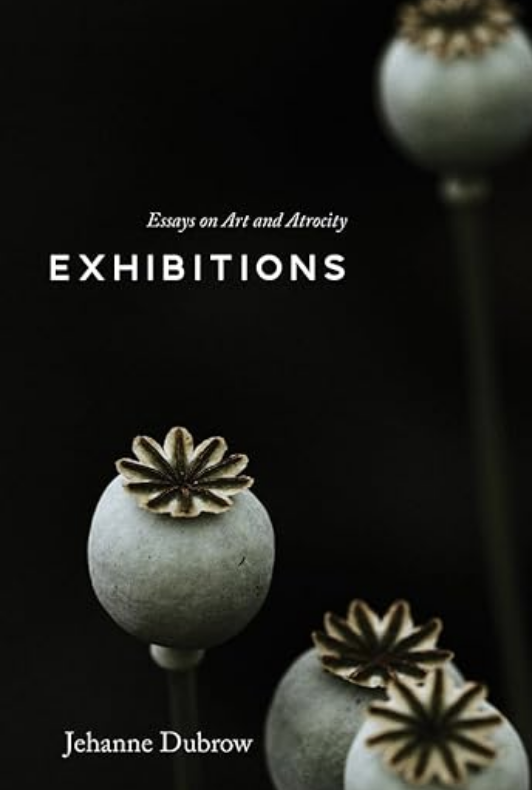Silvered Notes and Snapshots by Les Schofield
Exhibitions: Essays on Art and Atrocity
Jehanne Dubrow
University of New Mexico Press
147 pages
Exhibitions: Essays on Art and Atrocity is Jehanne Dubrow’s invitation to explore the unsettling proximity of beauty to barbarity. Imagined as six galleries in an atelier, Exhibitions displays her unflinching analysis of the ways specific artworks coexist within the atrocities of their time. On exhibit are the creations of writers, poets, artists, dramatists, architects, glassblowers, and craftsmen contextualized by the terrors they witnessed, endured, or inherited. Dubrow pauses before each piece, allowing the artist’s craftsmanship to give face to the maelstrom that howled it into being. She remains in place while we invite “the guest of beauty inside” and allow it to nudge us “a little beyond our own comfort.”
Dubrow wisely places silvered art notes between her exhibits allowing moments of respite from the litany of artistic witness to the atrocities that occurred in the Belgian Congo, Croatia, Bosnia, Herzegovina, Kosovo, Macedonia, Rwanda, and Auschwitz. These “snapshots” reflect her experiences as a child of diplomats who were proximate to many of those genocides. She includes provocative musings about her personal and academic life that undergird her authority as a trustworthy guide. There are brief snatches of her own poetry in the voice of another speaker—a trick her mother used when collecting the stories of Bosnian women who were victims of systematic rape. Although fluent in Serbo-Croatian, her mother used a translator during the interviews. “She wanted to construct a small, artificial barrier of language, so that the women’s trauma might take longer to reach her.” These moments witness Dubrow’s understanding of art as a way to stand close to the hell of atrocity without being consumed by its fire.
Exhibitions is illuminated by Dubrow’s awakening to and subsequent exploration of her identity as a Jew. “I am eleven or twelve when I begin to realize we are Jews.” Her family was not religious although there were hints of her heritage in the quiet rituals with food at Chanukah. A comment she makes about viewing plundered artifacts in a Belgian museum is applicable: “In all those years, I never saw what I was seeing.” Her epiphany occurred at the American School in Warsaw at the hands of her classmates. “‘Kike,’” they say, or “‘Zyd.’” In the eighth grade, the other students left a note in her locker. “‘Monster,’” it says. “‘You’re disgusting.’” She recognizes it as “… a note of exclusion” that produced a growing awareness she had inherited antipathy and atrocity. She explores this facet of her life throughout Exhibitions without letting its glow overpower the objects of her scrutiny. As a scholar of the Holocaust, she is “… able not to weep … barely gulp with nausea” and thus succeeds in keeping the light on her theme. But one cannot help noting the pathos she abhors languishing in the shadowed edges of her exhibits.
This is a masterpiece of interlocking essays that reflect on the way art functions in the presence of atrocity. Dubrow’s exhibit of Gunter Demnig’s “stumbling stones” shows art as impassioned witness that lifts the dead out of the dust of forgetfulness and loss. Often, art is simply an expression of trauma, as she points out using Mersad Berber’s artwork as an example. Then sometimes, art can be acts of willful turning away, as seen in Dubrow’s engagement with Debra Silverman’s insights into Art Nouveau structures and artwork that cast “a haze of decorative smoke” over the cruelty in the Congo Free State. Even then, the witness to atrocity is imbedded in the thin, graceful lines and vibrant colors that try to mask it. While she firmly holds that “… history and literature and art and theory must overlap to tell the full story of the horror,” she makes a compelling case for the indispensable role of art in translating atrocity for the living.
While Exhibitions is an unquestionable work of “… research and rigor; …ethos and logos rather than pathos,” every line is an expression of her poetic anima. The result is a Guernica of lyrical prose that confirms her unsettling observation about beauty. “Here is one of the problems with the beautiful. It exists, even adjacent to horror. And the writer, confronting this fact, finds his language conceding as well, words made lyrical despite themselves.” Dubrow has created a work that in itself is a product of atrocity, an exhibition of the very theme she explores and explains. Exhibitions deserves its own gallery in the atelier of art and atrocity.
Les Schofield is writer and artist living in North Carolina. For the past several years, he has taught theater arts, traditional woodcraft, and set design. He has studied art, philosophy, classical languages and holds an MFA in Creative writing. He was raised in the southwest and southern California before moving to the Appalachian Mountains of North Carolina where he married his wife, Kathy who is a professional folk artist. He is a member of the North Carolina Poetry Society and the North Carolina Writer’s Network. His current work in progress is entitled “Hominy Creek” which is an historical novel of the American Revolution as it played out in the Carolinas. He was recently interviewed in Southern New Hampshire University Online MFA Newsletter, Issue 10, Spring 2023.


